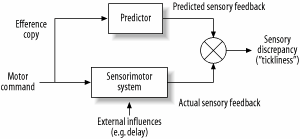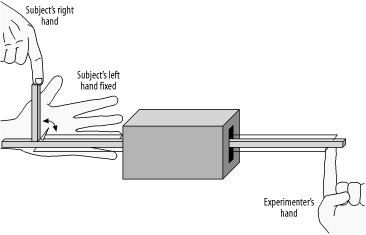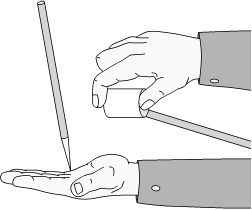Hack65.Why Can t You Tickle Yourself?
|
Hack 65. Why Can't You Tickle Yourself?
Experiments with tickling provide hints as to how the brain registers self-generated and externally generated sensations. Most of us can identify a ticklish area on our body that, when touched by someone else, makes us laugh. Even chimpanzees, when tickled under their arms, respond with a sound equivalent to laughter; rats, too, squeal with pleasure when tickled. Tickling is a curious phenomenon, a sensation we surrender to almost like a reflex. Francis Bacon in 1677 commented that "[when tickled] men even in a grieved state of mind . . . cannot sometimes forebear laughing." It can generate both pleasure and pain: a person being tickled might simultaneously laugh hysterically and writhe in agony. Indeed, in Roman times, continuous tickling of the feet was used as a method of torture. Charles Darwin, however, theorized that tickling is an important part of social and sexual bonding. He also noted that for tickling to be effective in making us laugh, the person doing the tickling should be someone we are familiar with, but that there should also be an element of unpredictability. As psychoanalyst Adam Phillips commented, tickling "cannot be reproduced in the absence of another." So, for tickling to induce its effect, there needs to be both a tickler and a ticklee. Here are a couple of experiments to try in the privacy of your own homeyou'll need a friend, however, to play along. 6.5.1. Tickle PredictingFirst, you can look at why there's a difference between being tickled by yourself and by someone else. 6.5.1.1 In actionTry tickling yourself on the palm of your hand and notice how it feels. It might feel a little ticklish. Now, ask a friend to tickle you in the same place and note the difference. This time, it tickles much more. 6.5.1.2 How it worksWhen you experience a sensation or generate an action, how do you know whether it was you or someone else who caused it? After all, there is no special signal from the skin receptors to tell you that it was generated by you or by something in the environment. The sensors in your arm cannot tell who's stimulating them. The brain solves this problem using a prediction system called a forward model. The brain's motor system makes predictions about the consequences of a movement and uses the predictions to label sensations as self-produced or externally produced. Every time an action is made, the brain generates an efference copy of the actual motor command in parallel. The efference copy is just like a carbon copy, or duplicate, of the real motor command and is used to make a prediction about the effect of the action, for example, the tickling effect of a finger stroke. The predicted sensory effect of the efference copy and the actual sensory effect of the motor command are compared (Figure 6-3). If there is a mismatch, the sensation is labeled as externally generated. Figure 6-3. Forward model: an internal predictor uses information about movements to distinguish between self-produced and externally produced sensations Your accurate prediction of the consequences of the self-tickle reduces the sensory effects (the tickliness) of the action, but this does not happen when someone else tickles you. This explains why the sensation is usually more intense when another person touches your arm compared with when you touch your own arm. Neuroimaging studies using a tickling machine (Figure 6-4) at University College London1 suggest that the distinction between self and other is hardwired in the brain. This device was used to apply a soft piece of foam to the participant's left palm. In one condition, the participant self-produced the touch stimulus with his right hand, and in the other condition, the experimenter produced the stimulus. The participant's brain was scanned during the experiment to investigate the brain basis of self-produced versus externally produced touch. Results show stronger activation of the somatosensory cortex and anterior cingulate, parts of the brain involved in processing touch and pleasure, respectively, when a person is tickled by someone else, compared with when they tickle themselves. The cerebellum, a part of the brain that is generally associated with movement, also responds differently to self-produced and externally produced touch, and it may have a role in predicting the sensory consequences of self-touch but not external touch. (See [Hack #7] for more about these parts of the brain.) Figure 6-4. Tickling machine: this device was used to apply a soft piece of foam to the participant's left palm One study used two robots to trick the brain into reacting to a self-tickle as if it were an external tickle.2 In the left hand, participants held an object attached to the first robot. This was connected to a second robot, attached to which was a piece of foam that delivered a touch stimulus to the palm of the right hand. Movement of the participant's left hand therefore caused movement of the foam, as if by remote control. The robotic interface was used to introduce time delays between the movement of the participant's left hand and the touch sensation on the right palm, and participants were asked to rate the "tickliness" (Figure 6-5). Figure 6-5. Tickling robots: participants found the stimulus more tickly as the time delay increased When there was no time delay, the condition was equivalent to a self-produced tickle because the participant determined the instant delivery of the touch stimulus by movements of the left hand. Greater delay between the causal action and the sensory effect (up to 300 ms) meant participants experienced the touch as more tickly.This suggests that, when there is no time delay, the brain can accurately predict the touch stimulus so that the sensory effect is attenuated. Introducing a time delay increases the likelihood of a discrepancy between the predicted and actual sensory effect. As a result, there is less attenuation of the tickly sensation, which tricks the brain into labeling the stimulus as external. By making the consequences of our own action unpredictable, therefore, the brain treats the self as another. 6.5.2. Force PredictionYou can see how we anticipate a stimulus and compensate for it, by attempting to estimate a force and seeing whether you can get that right. 6.5.2.1 In actionUse your right index finger to press down gently on the back of a friend's hand. Your friend should then use her right index finger to press down on the same spot on your hand with the same force that she felt from your finger press. Continue taking turns at thisreproducing the same force each timeand you may notice that after about 10 turns, the forces of your finger presses are getting stronger. 6.5.2.2 How it worksThis predictive process may also be at the root of why physical fights tend to escalate. Notice how tit-for-tat tussles between children (or indeed brawls between adults) intensify, with each person claiming that the other hit him harder. In a recent study,3 a motor was used to apply a brief force to the tip of each participant's left index finger. Participants were then asked to match the force they felt using their right index finger to push down on their left index finger through a force transducer. Results showed that participants consistently applied a stronger force than that which was applied to them. The authors suggest that, just as when we try to tickle ourselves, the brain predicts the sensory consequences of the self-generated force and then reduces the sensation. We can only predict the outcome of our own actions and not of someone else's, so an externally generated force feels more intense. As a result, if you were to deliver a vengeful punch to match the force of your opponent's blow, it is likely that you would overestimate the strength of the opponent's punch and strike back harder. Why have we evolved the inability to tickle ourselves? The force generation experiment shows that sensations that are externally caused are enhanced. Similarly, our reactions to tickling may have evolved to heighten our sensitivity to external stimuli that pose a threat. Our sensory systems are constantly bombarded with sensory stimulation from the environment. It is therefore important to filter out sensory stimulation that is uninterestingsuch as the results of our own movementsin order to pick out, and attend to, sensory information that carries more evolutionary importance, such as someone touching us. When a bee lands on your shoulder or a spider climbs up your leg, the brain ensures that you attend to these potentially dangerous external stimuli by ignoring feelings from your own movements. The predictive system therefore protects us and tickling may just be an accidental consequence. 6.5.3. End Notes
6.5.4. See Also
Suparna Choudhury and Sarah-Jayne Blakemore |
|
EAN: N/A
Pages: 159